ISSN ONLINE(2278-8875) PRINT (2320-3765)
ISSN ONLINE(2278-8875) PRINT (2320-3765)
| Savita Srivastava1, Dr. Deepak Nagaria2 |
| Related article at Pubmed, Scholar Google |
Visit for more related articles at International Journal of Advanced Research in Electrical, Electronics and Instrumentation Engineering
In this paper design of high performance FIR filter using Vedic mathematics is presented. Vedic mathematics is ancient Indian system of Mathematics. The Vedic multipliers used in the paper are Urdhava Triyakbhyam multiplier and Nikhilam Navatascharama multiplier. These algorithms utilize minimum computation time and can be used for multiplication of all type of numbers. The performance of Nikhilam multiplier is compared with Urdhava Triyagbhyam multiplier and Conventional method in order to highlight the speed superiority by reducing the computation time. The magnitude responses of FIR filter are also observed at different filter order. This multiplier enhances the performance of digital signal processor. The coding is done in MATLAB to find the filter coefficients.
KEYWORDS |
| Urdhava Triyagbhyam sutra, Nikhilam sutra, Vedic Mathematics, FIR Filter, MATLAB |
INTRODUCTION |
| Multipliers are one of the most powerful tools of digital signal processing for performing different operations like filter design, convolution, FFT, circular convolution[1]. The speed of processor depends on the speed of multipliers. Hence fast multiplication operations are extremely important in digital signal processing [2]. One of the most commonly used applications in DSP is FIR filter design. Fir filter are highly stable filter and are simple to design. In signal processing, convolution method is used in the design of FIR filter [3]. FIR filter is also called convolution filter; as multiplication of sequence in time domain is equivalent to convolution in frequency domain [4]. This paper represents designing of high performance FIR filter using window method based on Vedic multiplier technique by using the algorithm of Nikhilam sutra which increases the speed of multipliers by reducing number of iterations. This multiplier enhances the performance of digital signal processor |
II.LITERATURE SURVEY |
| Akalesh k.itawadiya. et.al describes the DSP operations using Vedic Mathematics in their research. In this paper, they proposed an algorithm for DSP operations (linear convolution, circular convolution, correlation) using Urdhava Triyagbhyam. The fast computation of DSP operation of two finite length sequences was performed in single GUI window. They have provided the information that DSP operation based on Urdhava Triyagbhyam method of Vedic mathematics reduced the processing time as compared to inbuilt function of MATLAB [6] |
| Tushar shukla.et.al. presented a design of high speed multiplier for FIR filter using window. In this paper they have describe the methodology of FIR filter design based on linear convolution concept using Urdhava Tiryagbhyam method. The FIR filter design using windows (Flat Top, Gaussian, triangular) are implemented by Urdhava Tiryagbhyam multiplication algorithm in GUI. They have claimed that FIR filter based on Vedic method consumed less average execution time as compared to inbuilt function of MATLAB [7]. |
| Harpeet singh dhillion.et.al. proposed a multiplier using ‘Urdhava Triyagbhyam’ algorithm, which is optimized by ‘Nikhilam’ algorithm. They have suggested a reduced bit multiplication using ‘Urdhava Tiryagbhyam’ sutra and ‘Nikhilam’ sutra [8]. |
III.VEDIC MATHEMATICS |
| Vedic Mathematics is ancient Indian system of mathematics that was rediscovered in the early twentieth century by Swami Bharati Krishna Teerthaji Maharaj from ancient Indian scriptures. In 1884-1960, Swami Bharati Krishna Teerthaji Maharaj, a scholar of puri, rediscovered the ancient Indian mathematics from Atharva. After extensive research on Atharva, swamiji developed unique of calculation based on 16 sutras and 13 sub sutras and this ancient system of mathematics is called Vedic mathematics. [8, 9] |
| Vedic means ‘to know without limit’. It is derived from Sanskrit word ‘Veda’. Vedic mathematics has unique technique of calculation based on simple rule and principle with which mathematical problem can be solved easily. The caliber of Vedic mathematics is lies in the fact that it simplified and optimized the complex looking problem in conventional mathematics to simple one. This is so because the Vedic mathematics formulae are claimed to be based on the natural Principles and simple which the human mind function |
| Vedic mathematics is based on 16 sutras and 16 subsutras which can be applied to arithmetic, trigonometry, algebra, geometry, calculus. Vedic mathematics holds two sutras for performing multiplication. These Vedic mathematics formulae are not to be found in present text of Atharva Veda because these formulae were constructed by Swamiji himself. Vedic mathematics is not only a mathematical wonder but also it is logical [10]. That’s why Vedic mathematics has such a degree of eminence which cannot be disapproved. These VM formulas can be used for the implementation, computation and optimization of digital multipliers in the design of digital signal processing. |
IV.URDHAVA TIRYAGBHYAM SUTRA |
| ‘Urdhava’ and ‘Tiryagbhyam’ sutra words are derived from Sanskrit literature which means ‘vertical and crosswise’. It is general multiplication formula applicable to different cases of multiplication. Urdhava Tiryagbhyam generates all partial products with concurrent addition of these partial products. Urdhava sutra is used in the generation of parallelism of partial product and their sums [11,12]. This sutra can be generalized for N*N bit number. This multiplier is independent of clock frequency of the processor.` |
METHDOLOGY OF MULTIPLICATION OF TWO DECIMAL NUMBERS: |
| ïÃâ÷ Least significant digit on both side of line is multiplied vertically to get their product. This generates one of the bits and a carry. This carry is added in next step |
| ïÃâ÷ The digit on both side of the line is multiplied crosswise, and then the two are added to get their result as a sum in which pre-carry is added. |
| ïÃâ÷ Hence the process continues; and in each step, least significant bit acts as the result bit and all other bit acts as the carry for the next step. |
| To illustrate this methodology, let us consider the multiplication of two decimal numbers (25 * 35). |
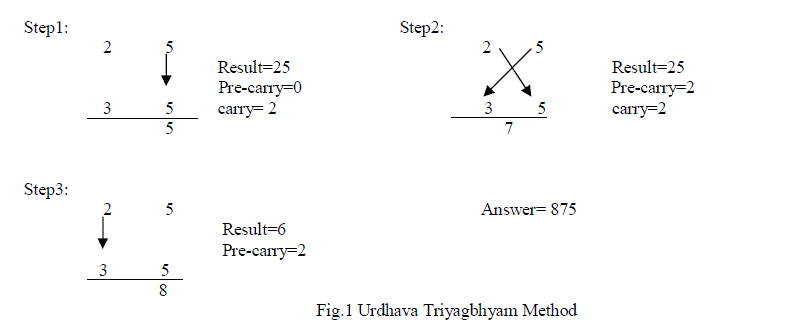 |
V.NIKHILAM NAVATASCHARAMA SUTRA |
| Nikhilam sutra literally means ‘all from nine and last from ten’. It converts large digit multiplications into smaller multiplication by few additions, subtraction and shift operations. It reduces the number of iterations by reducing the whole multiplication [13,14]. |
METHDOLOGY OF MULTIPLICATION OF TWO NUMBERS |
| ïÃâ÷ Estimate the compliment of multiplier and multiplicand. These are put against them respectively. |
| ïÃâ÷ Compute the product of the compliment and result is set in right side of final result. Further calculate the cross sum or cross subtraction of two digits and result is set in left side of final result. |
| ïÃâ÷ The final result is obtained by concatenating LHS and RHS. To illustrate this methodology, let us consider the multiplication of two decimal numbers (99 * 98). |
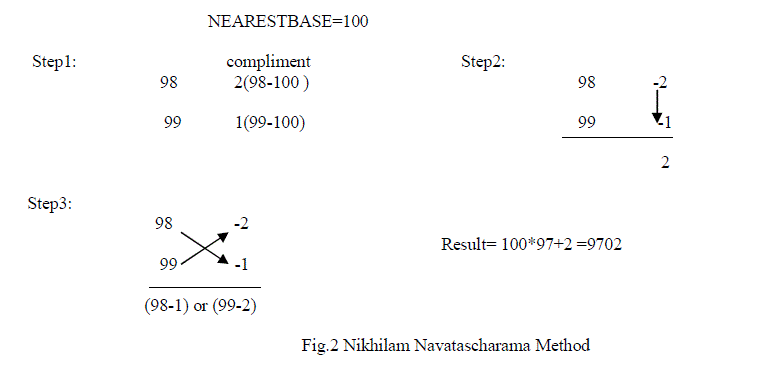 |
VI.IMPLEMENTATION IN FIR FILTER |
| FIR filters are generally preferred in several applications because they provide an exact linear phase over the whole frequency range and they are always stable. FIR filter are all zero filter and its input output relation is obtained by using the equation of linear convolution [15, 16, 17]: |
 |
| In FIR filter input sequence x(n) and filter coefficient sequence h(n) are finite. Hence the convolution of input sequence x (n) with h (n) gives output sequence y (n). Thus the out response is expressed as |
 |
| By expanding the equation we get, |
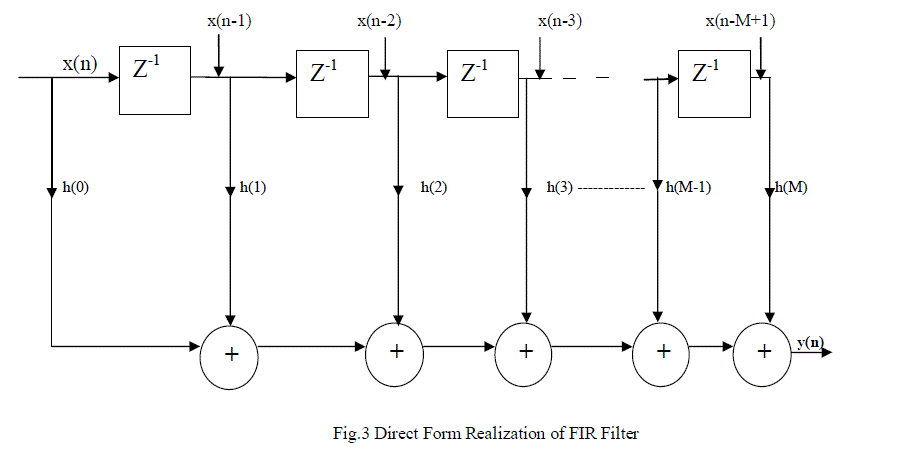 |
| The above figure is direct form realization of FIR filter which is obtained from the expansion of equation (2).this structure has ‘R-1’ addition and “R’ multiplication. |
| It is simple to design FIR filter using window method. In the window method, the desired response specification Hd (w), corresponding unit sample response hd (n) is determined using the following relation: |
 |
| To design a FIR filter, length of output sequence must be finite. So window function is used to truncate filter coefficient and sample at point M-1 to minimize computation time and make causal shift [18, 19]. |
VII.RESULT AND OBSERVATION |
| In this paper FIR Low Pass Filter is designed using windows (Hamming, Hanning, Blackman, and Kaiser). The filter specifications are real world and MATLAB is used to find out the Filter coefficients. MATLAB is a software package of fourth generation programming language. It has its own high level programming language for computing technical numeric and visualization |
| Although any filter specification can be taken but for the sake of implementation the following are considered for FIR Low Pass filter. |
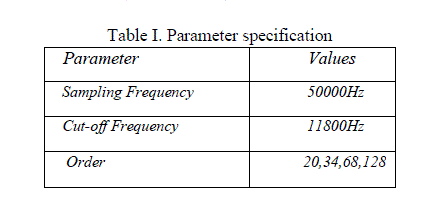 |
| The filter coefficients are obtained from the relation [20, 21] |
| h (n) = hD (n) . w (n)->Vedic multiplication |
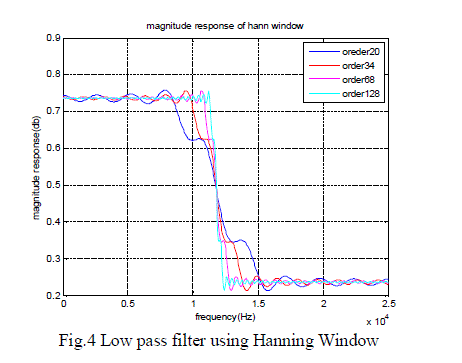 |
| Figure 4 gives magnitude response of FIR Low Pass filter of 20,34,68,128 order and at particular cutoff frequency of 11800Hz and sampling frequency of 50000Hz using hanning window which shows that , with increase in M the main lobe becomes narrower, side lobe amplitudes remain unaffected but width of the side lobes decreases. |
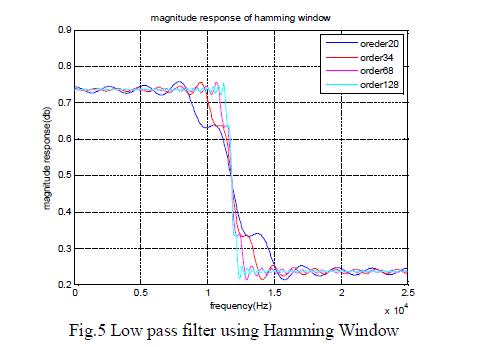 |
| Figure 5 gives magnitude response of FIR Low Pass filter of 20,34,68,128 order and at particular cutoff frequency of 11800Hz and sampling frequency of 50000Hz using hamming window which shows that , with increase in M the main lobe becomes narrower, side lobe amplitudes remain unaffected but width of the side lobes decreases. The Hamming window exhibits similar characteristics to the Hanning window but further suppresses the first side lobe. |
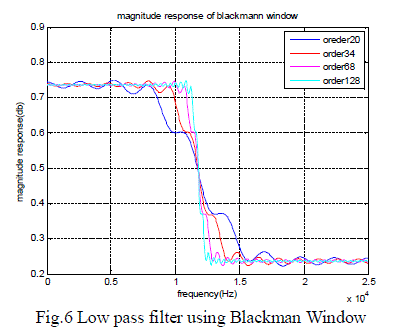 |
| Figure 6 gives magnitude response of FIR Low Pass filter of 20,34,68,128 order and at particular cutoff frequency of 11800Hz and sampling frequency of 50000Hz using blackman window which shows that , with increase in M the main lobe becomes narrower and width of the side lobes decreases. An advantage with the Blackman window over other windows is that it has better stop band attenuation and with less pass band ripple. |
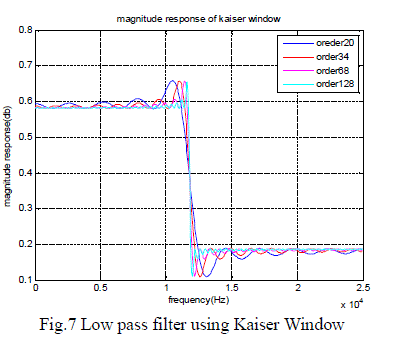 |
| Figure 7 gives magnitude response of FIR Low Pass filter of 20,34,68,128 order and at particular cutoff frequency of 11800Hz and sampling frequency of 50000Hz using Kaiser window which shows that , with increase in M the main lobe becomes narrower and width of the side lobes decreases. Kaiser window is most commonly used window in FIR filtering because shape of main lobe and side can be adjusted by selection of M and alpha. |
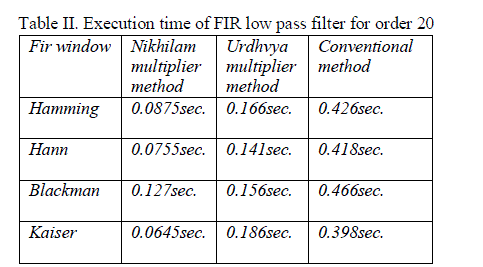 |
| Table II represents Vedic multipliers versus conventional average proposed time comparison for various window of 20 order low pass FIR Filter with input as unit impulse signal. The Comparisons suggest that the execution time taken by Vedic Method is less as compared to conventional method. Thus Nikhilam sutra of Vedic method is proved to be faster as compare to Urdhava Triyagbhyam of Vedic method and Conventional method. |
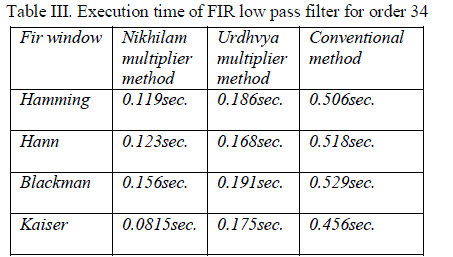 |
| Table III represents Vedic multipliers versus conventional average proposed time comparison for various window of 34 order low pass FIR Filter with input as unit impulse signal. The Comparisons suggest that the execution time taken by Vedic Method is less as compared to conventional method. Thus Nikhilam sutra of Vedic method is proved to be faster as compare to Urdhava Triyagbhyam of Vedic method and Conventional method |
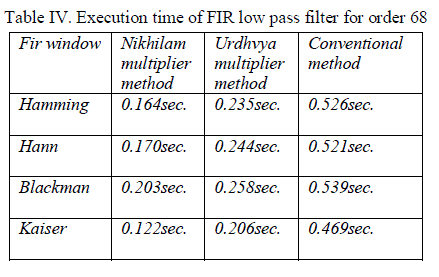 |
| Table IV represents Vedic multipliers versus conventional average proposed time comparison for various window of 68 order low pass FIR Filter with input as unit impulse signal. The Comparisons suggest that the execution time taken by Vedic Method is less as compared to conventional method. Thus Nikhilam sutra of Vedic method is proved to be faster as compare to Urdhava Triyagbhyam of Vedic method and Conventional method |
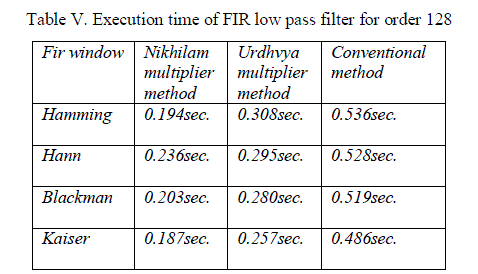 |
| Table V represents Vedic multipliers versus conventional average proposed time comparison for various window of 128 order low pass FIR Filter with input as unit impulse signal. The Comparisons suggest that the execution time taken by Vedic Method is less as compared to conventional method. Thus Nikhilam sutra of Vedic method is proved to be faster as compare to Urdhava Triyagbhyam of Vedic method and Conventional method. |
VIII.CONCLUSION |
| The proposed Vedic multiplier method in FIR filter shows sufficient speed improvement. In this work, execution timing proved that Nikhilam multiplier is giving better speed of response by reducing the computation time in comparison to Urdhava multiplier and Conventional methods. Vedic multiplier provides many interesting sutras but their application has not been fully exploited to the field of digital signal processing. Further work using Nikhilam Sutra is in DFT, Image Processing, IFFT, FFT |
References |
|